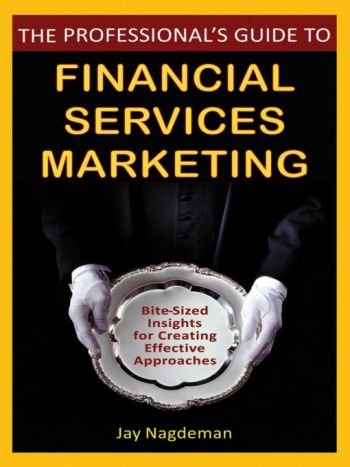Bite-sized marketing nuggets
Book Review: Bite-sized marketing nuggets
- |
- Written by Joseph B. Frederick
- |
- Comments: DISQUS_COMMENTS
 The Professional’s Guide to Financial Service Marketing: Bite-Sized Insights For Creating Effective Approaches. By Jay Nagdeman, 288 pp., Wiley.
The Professional’s Guide to Financial Service Marketing: Bite-Sized Insights For Creating Effective Approaches. By Jay Nagdeman, 288 pp., Wiley.
To read Frederick’s previous review of Retiring the Generation Gap: How Employees Young & Old Can Find Common Ground, click here
The opportunities and challenges of marketing financial services are discussed by Jay Nagdeman in The Professional’s Guide to Financial Service Marketing. Nagdeman accurately describes financial services marketing as both an art and a science. Financial services are less tangible than other products, and therefore results are not always immediate. This poses special difficulties for the marketing professional. Writing to a theme that successful marketing doesn’t cost, but pays, Nagdeman draws on his experience of over 25 years in the industry. His work is not a how-to manual, but instead inspires thoughts and ideas to market financial services effectively and efficiently.
The book is well organized in eight broad sections:
• Creating an Extraordinarily Effective Marketing Organization
• Strategic Planning
• Tactical Implementation
• Promotion
• Effective Sales Support
• Supporting Strategic Decision Making
• Promotion in the Internet Age
• Strategies for Long-Term Success
Each section offers short chapters that flow quickly and concisely, making the book easy and compelling to read. The author is at his best using anecdotes and examples to illustrate his points, whether from a bank, a financial services firm, or a grocery store, and applying the concepts to universal marketing situations. Each chapter ends with a compact summary of a few conclusive messages and ideas which Nagdeman names “The Bottom Line.”
Nothing defines the purpose of the organization better than a mission statement and Nagdeman gives five valuable tips to create one. While some organizations take pride at not having a mission statement, nothing is more important to define organizational purpose and the author makes this one of his first chapters.
Nagdeman also emphasizes the importance of name—the art of branding the company with an enduring synonym in the mind of the customer. Two sections in the book, “Tactical Implementation” (Section III) and “Promotion” (Section IV), discusses the importance of name.
Naming the company may leave little doubt as to what it does—for example, U.S. Bank. Whereas the Morgan Stanley name relies on provenance and represents another way to create the name. A name can be contrived—which can be powerful when it works—such as Google—or a millstone—Edsel—when it doesn’t. A name may link itself to an association or metaphor (Visa Credit Card) to facilitate branding and name establishment. A good brand has a difficult time overcoming a bad name while the right name provides a springboard for lower-cost branding, capturing the mind of the customer and achieving market place success.
Purposefully cultivating and developing referrals is a powerful marketing technique. Chapter 35, “Mobilizing an Effective Sales Force,” describes an innovation using the power of celebrity endorsement without a celebrity. Instead, shareholders or satisfied clients with proper education and incentives promote the organization. Leveraging relationships between referrers and prospects can lead to results that are difficult for any bank or financial services organizations’ management team to duplicate on their own.
The concept of social marketing is illustrated in Chapter 31, when American Express made a $1.7 million dollar contribution to the Ellis Island Foundation while reportedly spending $6 million to publicize the program. Critics felt the generous donation would have been better received if the result was larger than the money spent achieving it.
Common-sense reminds readers of what they may take for granted. For example, “Advertising does not sell products, people do”; “If you give people what they need, you can make a living but if you give them what they want, you can make a fortune” and “If you don’t know where you’re going, any road will take you there.” The book includes stories and parables which can be applied to marketing financial services. The author uses Sun Tzu in the ancient book, The Art of War, as a metaphor for planning as the activity that enables one party to triumph over another.
No work on the marketing of financial services would be complete without discussion of the internet and Nagdeman does not disappoint in discussing the internet world. The age of the internet produced a complete evolution in strategy and he devotes five chapters to this evolving topic. Simply keeping current with internet promotion offers a formidable challenge. Nagdeman writes about e-marketing and online promotion, pointing out that it took 40 years for television to acquire ten million users while Hotmail had ten million in the first year. As of this writing, Facebook, with 250 million users, would be the sixth largest nation if the users were a country.
Nagdeman quotes Abraham Lincoln who said “If I had only three hours to cut down a tree, I would spend the first two sharpening the axe.” Readers wanting to gain new perspectives, advantages, and a thorough understanding of financial services marketing will be well served by spending the first few hours reading this book.
If you'd like to review books for our online book column, or have recently read a book that you found helpful that we haven't already reviewed, please e-mail [email protected]
Want more banking news and analysis?
Get banking news, insights and solutions delivered to your inbox each week.
Tagged under Books for Bankers,













